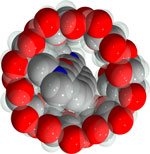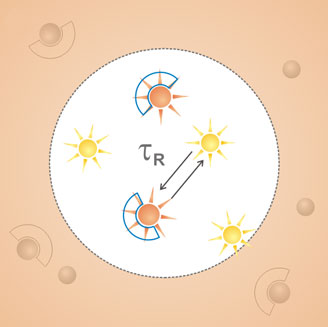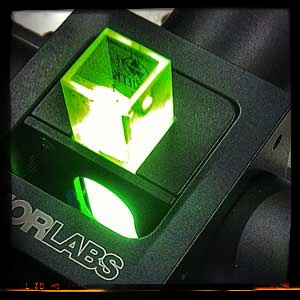Research
 Mercedes Novo and Wajih Al-Soufi
Mercedes Novo and Wajih Al-Soufi
Amyloid fibrils are insoluble aggregates with fibrillar morphology and β-sheet-rich structure that cause several diseases called amyloidosis due to their misfolding. Among the different amyloid-like peptides, those called amyloid-β are very important because of their primal role in the Alzheimer’s disease. They accumulate as insoluble plaques at the brain formed mainly by peptides of 40 and 42 aminoacids (Aβ40 and Aβ42), being the latter at higher proportion.
Applying our experience in detailed photophysical studies and in single molecule techniques we pursue several research lines:
- Study of the formation of early aggregates of amyloids-β as toxic agents in Alzheimer's disease
- Development of fluorescent markers for the quantitative detection of amyloid-β aggregates
- Photophysical characterization of Thioflavin T (ThT), the most common marker used for the detection of amyloid fibrils

Mercedes Novo and Wajih Al-Soufi
Surfactants are interesting model molecules for the study of both self-assembling and host-guest supramolecular systems. Having many similarities with biological membranes, they are much simpler systems where matter exchange can be easier studied. Our studies of the exchange dynamics of dyes with surfactant micelles using FCS confirmed that micelles act as soft-cages with a diffusion controlled rate constant of the dye-micelle association.
We present a model for the concentrations of monomeric and micellized surfactant as function of the total surfactant concentration. This concentration model provides an objective definition of the critical micelle concentration (cmc) and yields precise and well defined values of the cmc and derived physical parameters. The use of a general concentration model eliminates subjective graphical procedures, reduces methodological differences, and thus allows one to compare directly the results of different techniques or to perform global fits. This model is also applicable to other self aggregating systems such as proteins or polymers.
Mercedes Novo and Wajih Al-Soufi
 Host-Guest complexes are supramolecular aggregates stabilized by non-covalent bonds and are ubiquitous in biochemical, pharmaceutical, environmental, cosmetic, food, and other chemical systems and applications. Different approaches are necessary in order to fully understand a supramolecular system: structural studies yield stoichiometry, geometry, association sites and heterogeneity; thermodynamic studies provide information about stability, equilibrium constants and reversibility; and finally dynamic studies are necessary to describe the association dynamics, diffusional properties or conformational dynamics. Most published studies focus on structure and thermodynamics of supramolecular association, which, however, give very little information about the dynamics of the system.
Host-Guest complexes are supramolecular aggregates stabilized by non-covalent bonds and are ubiquitous in biochemical, pharmaceutical, environmental, cosmetic, food, and other chemical systems and applications. Different approaches are necessary in order to fully understand a supramolecular system: structural studies yield stoichiometry, geometry, association sites and heterogeneity; thermodynamic studies provide information about stability, equilibrium constants and reversibility; and finally dynamic studies are necessary to describe the association dynamics, diffusional properties or conformational dynamics. Most published studies focus on structure and thermodynamics of supramolecular association, which, however, give very little information about the dynamics of the system.
It is our aim to exploit Fluorescence Correlation Spectroscopy (FCS) for the study of supramolecular association and, more specifically, of the stability and the binding dynamics in host-guest systems. We show how knowledge about the dynamics gives valuable information about the association mechanism, which is directly related to the structure of the host and the guest.
 Mercedes Novo and Wajih Al-Soufi
Mercedes Novo and Wajih Al-Soufi
Fluorescence Correlation Spectroscopy (FCS) is a powerful single molecule technique for the study of the stability and the association dynamics of supramolecular systems and, in particular, of host-guest inclusion complexes. With FCS the host-guest binding equilibrium constant is determined analysing the variation in the diffusion coefficient of the fluorescent guest or host with no need for a change in the photophysical properties of the fluorescent probe. FCS gives also access to the association/dissociation rate constants of the host-guest inclusion providing that the fluorescence intensity of host or guest changes upon complexation.
Here we share details of the instruments we develop in our laboratory. We invite you to use this information for your own needs. Please give us feedback!
 Illuminator: Setup for the irradiation of small liquid samples with continous high power LED light.
Illuminator: Setup for the irradiation of small liquid samples with continous high power LED light.
Wajih Al-Soufi, 2014
Mercedes Novo and Wajih Al-Soufi
During the past decades there has been a great interest in the design of high-affinity, sequence-specific DNA binders interacting either with the major or with the minor groove due to their potential medical applications. Especially relevant are fluorogenic binders that show high detection sensitivity to DNA sequences. This sensitivity depends on the magnitude of the fluorescence increase upon binding and is related to the photophysics of the binder, and to the affinity constant, which in turn is determined by the dynamics of the binding process. Therefore, the progress in the design of DNA binders requires thorough photophysical studies and precise determination of the involved association and the dissociation rate constants.



